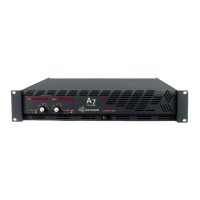
Do you have a question about the Altair A3.5 and is the answer not in the manual?
Improved DC output protection by relay and solid state sensors.
Soft-clipping circuit prevents distortion and protects speakers.
Near zero output impedance for precise loudspeaker voice coil control.
Details controls and indicators on the front of the amplifier.
Details connections and switches on the rear of the amplifier.
Essential warnings regarding high voltage, moisture, heat, and output connectors.
Procedure for unpacking and inspecting the amplifier upon arrival.
Guidelines for rack mounting and ensuring proper cooling.
Procedure for replacing fuses, including correct fuse types.
Procedure for connecting the amplifier to the AC power supply.
Details on balanced and unbalanced input connections using XLR connectors.
Guidelines for connecting speakers and avoiding shorts.
Configuration and wiring for independent channel operation.
Configuration and wiring for combining channels for higher power.
Steps for safely powering on the amplifier and waiting for signal connection.
Explanation of input signal attenuators and their independent control.
Description of CLIP, SIGNAL, and ON/PROTECT LEDs and their meanings.
Note on opening the unit for input sensitivity and limiter configuration.
Guidelines for using the amplifier with 70.7V/100V PA systems.
Description of the optional card providing high and low frequency outputs.
Specifications for output power in stereo and bridge modes at various impedances.
Details on total harmonic distortion, intermodulation distortion, and hum/noise.
Graph showing typical common mode rejection ratio versus frequency.
Graph showing frequency response at rated output into 4 ohms.
Graph illustrating channel separation between left and right channels.
Graph showing total harmonic distortion versus frequency at rated output.
Details of the one-year warranty against manufacturing flaws.
Information on sending faulty units and excluded modifications.